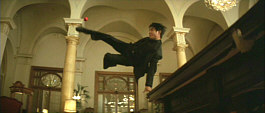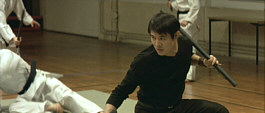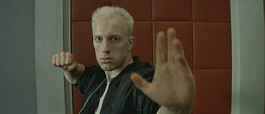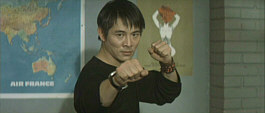Kiss of the Dragon appears in an aspect ratio of approximately 2.35:1 on this single-sided, dual-layered DVD; the image has been enhanced for 16X9 televisions. Overall, the picture looked fairly good, but it betrayed a few more concerns than Iíd expect from such a recent film.
Sharpness consistently seemed good. A few wider shots appeared slightly soft, but these were very rare. As a whole, the picture remained crisp and distinct throughout the film. Jagged edges and moirť effects caused no concerns, but I did detect some light edge enhancement at times. Print flaws werenít a major issue, but they seemed a little too prominent for such a recent film. A little grain appeared, but the main problem stemmed from white speckles. These never came across as heavy, but I found them to occur too frequently.
Dragon offered a fairly cool and subdued palette that the DVD reproduced well. Very few bright or vivid colors appeared during the movie; probably Fondaís red jacket stood out as the boldest hue we saw on a consistent basis. Nonetheless, the image presented the tones with good accuracy and clarity. Black levels came across as reasonably deep and rich, but low-light sequences were slightly murky; they seemed a bit too thick and bland at times. Overall, Kiss of the Dragon offered a positive visual experience, but it wasnít great for a recent flick.
 The Dolby Digital 5.1 soundtrack of Kiss of the Dragon seemed somewhat superior, but it also wasnít among the best of the current era. The soundfield appeared fairly active throughout the film. The mix featured very frequent use of all five channels, and it often came across as lively and engaging. The effects received the best usage, as they displayed good activity from all sides. However, I thought the soundfield often felt excessively ďspeaker specificĒ, as the elements seemed to come from spots that were too easily distinguished. They blended together a little awkwardly and didnít pan terribly smoothly. To be sure, the movement wasnít poor, but it didnít sound as natural as Iíd expect. Frankly, the track came across as mildly gimmicky at times; it didnít always present a very realistic setting.
The Dolby Digital 5.1 soundtrack of Kiss of the Dragon seemed somewhat superior, but it also wasnít among the best of the current era. The soundfield appeared fairly active throughout the film. The mix featured very frequent use of all five channels, and it often came across as lively and engaging. The effects received the best usage, as they displayed good activity from all sides. However, I thought the soundfield often felt excessively ďspeaker specificĒ, as the elements seemed to come from spots that were too easily distinguished. They blended together a little awkwardly and didnít pan terribly smoothly. To be sure, the movement wasnít poor, but it didnít sound as natural as Iíd expect. Frankly, the track came across as mildly gimmicky at times; it didnít always present a very realistic setting.
Audio quality seemed good as a whole. Dialogue appeared natural and warm, with no signs of edginess or problems related to intelligibility. Music was robust and distinct. The movie combined a variety of different musical genres, but all came across as clear and vibrant, and they showed nice depth when appropriate. Effects also demonstrated solid accuracy. Those elements were clean and vivid, and they packed a good bass punch at times. Overall, much of the soundtrack for Kiss of the Dragon worked very well, but it simply didnít quite make it to ďAĒ level.
This release of Kiss of the Dragon doesnít quite compare to more elaborate Fox packages like The Phantom Menace or Planet of the Apes, but it packs some reasonable extras nonetheless. First up is an audio commentary from director Chris Nahon and actors Jet Li and Bridget Fonda. Each of the three was recorded separately for this edited, periodically screen-specific track. While I didnít think it was a great commentary, it offered enough interesting material to keep me going.
 Nahonís segments seemed the least compelling. He tended to discuss technical aspects of the filmmaking process, and he didnít offer much that appeared unique or terribly fascinating. On the other hand, Li provided some good anecdotes and gave us a different perspective on the process, while Fonda seemed very solid as she featured surprising insight into her character and acting in general. Probably the biggest hurdle found in the commentary relates to the accents of Li and Nahon, which made the piece slightly rough sailing at times. However, that wasnít a major concern, and overall, this commentary appeared fairly interesting.
Nahonís segments seemed the least compelling. He tended to discuss technical aspects of the filmmaking process, and he didnít offer much that appeared unique or terribly fascinating. On the other hand, Li provided some good anecdotes and gave us a different perspective on the process, while Fonda seemed very solid as she featured surprising insight into her character and acting in general. Probably the biggest hurdle found in the commentary relates to the accents of Li and Nahon, which made the piece slightly rough sailing at times. However, that wasnít a major concern, and overall, this commentary appeared fairly interesting.
In regard to the rest of the extras, we find a lot of material, but much of it seems fairly insubstantial. The first of many featurettes, Jet Li: Fighting Philosophy, offers a pretty dull program. The 11-minute and 25-second piece shows some decent behind the scenes footage mixed with movie clips, and we also get interviews from Li, Bridget Fonda, Tcheky Karyo, and director Nahon. While Li offers some moderately interesting information about his training and experience, for the most part this featurette exists to tell us how terrific Li is. As such, itís not terribly useful.
Much better is Cory Yuen: Action Academy. This eight-minute piece uses the same mix of shots from the set, film snippets and interviews as ďPhilosophyĒ, but in the latter category, it includes only one participant: fight choreographer Yuen. He offers some details about his training and gives us quite a lot of good information about his preparation for a film and the work he does for the flicks. Itís a surprisingly compelling and worthwhile little piece.
 Also solid is Police Gymnasium Fight: Martial Arts Demo. This splits into three areas. You can watch the final scene from the film, or you can watch ďDemo OneĒ, which runs 68 seconds, and ďDemo TwoĒ, which lasts 63 seconds. Each of the latter shows Yuen and some stunt performers as they block parts of the big gym battle. Itís very interesting to see the small bits come together, and I enjoyed this segment.
Also solid is Police Gymnasium Fight: Martial Arts Demo. This splits into three areas. You can watch the final scene from the film, or you can watch ďDemo OneĒ, which runs 68 seconds, and ďDemo TwoĒ, which lasts 63 seconds. Each of the latter shows Yuen and some stunt performers as they block parts of the big gym battle. Itís very interesting to see the small bits come together, and I enjoyed this segment.
On the Set Action is a moderately compelling little piece. The 126-second program simply combines finished film shots with corresponding behind the scenes footage from the set. Itís cut too choppily to be terribly useful, but itís kind of cool nonetheless.
Some storyboard materials appear next. The Storyboard to Scene Comparison looks at the ďLaundry ChuteĒ bit. You can watch the boards alone, the film on its own, or the two combined; the boards run on top and the film on the bottom for the 141-second split screen piece. We also get a Storyboard Sequence for ďThe OrphanageĒ. It appears as a running presentations that lasts three minutes, 10 seconds. Both are decent pieces for those who like storyboards, but they did little for me.
Next we find the generically named Featurette. This tosses in a couple of decent behind the scenes shots, but itís nothing we havenít already seen elsewhere on the DVD. Otherwise, the four-minute and 20-second clip just shows us lots of film snippets and bland interview segments from Li, Fonda and Karyo, all of which are designed to tout the film. Itís purely promotional and utterly skippable.
 The Action Gallery Production Stills offers a running display of photos. We see some posters, promotional shots, and candid images in this moderately interesting five and a half minute compilation.
The Action Gallery Production Stills offers a running display of photos. We see some posters, promotional shots, and candid images in this moderately interesting five and a half minute compilation.
The remainder of the extras fall into the promotional realm. We get the theatrical trailer for Dragon as well as ads for Behind Enemy Lines and Planet of the Apes. The DVD presents all in 1.85:1 nonanamorphic transfers with Dolby Digital 2.0 sound. A collection of six TV spots also appears.
At least one Easter egg shows up on the DVD as well. Go to the ďPolice Gymnasium Fight: Martial Arts DemoĒ page and highlight ďSpecial FeaturesĒ. Click ďupĒ and youíll highlight a dragon symbol on Liís shirt. Hit ďenterĒ and youíll get to see an international trailer for the film. It ainít much, but itís there.
That statement neatly encapsulates my thoughts about Kiss of the Dragon itself. The movie seems rather flat and uninvolving. I canít call it genuinely bad, but it never threatened to become anything very exciting or entertaining; itís a very pedestrian flick. The DVD offers fairly good picture and sound plus a decent but unspectacular roster of extras. Jet Li aficionados will probably want to give it a look, but those not already enamored of his work should skip it, as I doubt Dragon will earn him many new fans.



